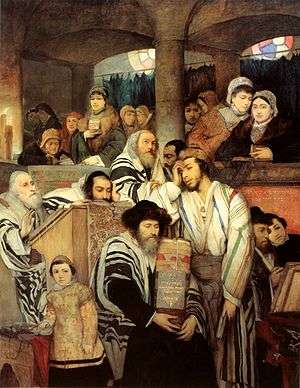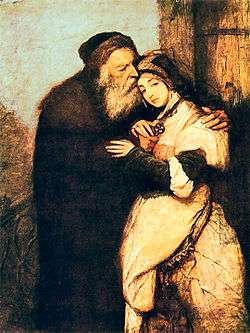Laura Henschel-Rosenfeld

Laura Henschel-Rosenfeld (December 25, 1857 – April 1944) a respected educator between the World Wars, was the fiancée of Maurycy Gottlieb, perhaps the most famous Jewish painter of his era, until she rejected him for another suitor. The rejection, according to some theories, directly led to the death of this painter in 1879 at the age of 23, 18 months after her rejection. Henschel-Rosenfeld herself was murdered by the Nazis 65 years later at Westerwald.[1] Henschel-Rosenfeld appears in some of Gottlieb's most famous paintings.
Early life
Laura Rosenfeld born on December 25, 1857 to Joseph Rosenfeld and Rosa Kolisch in Brno, the capital of Moravia. She was the youngest of 11 children.[2]
Laura attended a convent school in Lienz, Upper Austria, and then another near Geneva for three years, but despite her surroundings, continued to maintain the Jewish faith instilled in her by her mother. After her father died, her widowed mother moved with her to Vienna, where she was to have her first encounter with Maurycy Gottlieb probably in 1875 or 1876.[2]
Relationship with Maurycy Gottlieb
Maurycy Gottlieb was smitten by Rosenfeld, and soon proposed to her. She accepted, and became the subject of many of his paintings, including Portrait of Laura, Jews Praying in the Synagogue on Yom Kippur, Shylock and Jessica, Uriel Acosta and Judith.[3]


Gottlieb travelled between his hometown of Drohobych and Vienna, and soon Laura began to lose interest in him. Gottlieb sensing her distance in their letters became more and more anxious, until Laura finally confessed she had fallen in love with someone else.[2]

Gottlieb died on July 17, 1879, according to some, of a broken heart, intentionally letting his health fail, due to his despair over the failed romance.[4]
Laura evidently believed she was the cause of this death, later writing that she only consented to marry her subsequent suitor, a banker by the name of Leo Henschel, because he threatened to shoot himself if she did not. "I said yes because I could not forget the suicide of the young painter Gottlieb, two years before." (Evidence of Gottlieb's despair can also be found in his letters to Laura, and in the painting, Jews Praying in the Synagogue on Yom Kippur, where he placed his own name on the memorial inscription on the Torah mantle.)[2][5]
Life after Gottlieb
Laura married Leo Henschel a prosperous Berlin banker. She had four daughters, the eldest of whom perished in the Holocaust, one died at a young age, and the other two survived. The eldest daughter's name was Margarete Steiner-Henschel. She was murdered on August 31, 1944 in Auschwitz.[6] Margarete Steiner-Henschel and her mother Laura Rosenfeld-Henschel are commemorated on a memorial monument in Zeist.[7] (Bat Sheva Scheflan (1910-2007),[8] the daughter of Margarete Steiner-Henschel and granddaughter of Laura Henschel-Rosenfeld, later moved to Israel, to Kibbutz Heftziba. In 1955, together with her maternal aunt, Vali Marx, they donated Gottlieb's Portrait of Laura, to the Tel Aviv Museum of Art.)[9]
While Laura ran the busy Berlin household, she also continued to read and study. After her husband died in 1909, and her children had left home, Laura dedicated her life to education and social work. She worked in an orphanage for children of criminals, as a social worker among the needy segments of the population, and established a communal home near Berlin which stressed harmony and equality amongst its residents.
Later she founded "The House of the Order of the Free Spirit", which she called a "school for human education" and attracted many followers who knew her as "Mother Henschel". She was also active with feminist and human rights movements outside of Germany.[2]
Writings and philosophy
Laura Henschel-Rosenfeld was a prolific writer, penning some 150 volumes concerning her family history, childhood recollections and philosophical reflections. Virtually all were lost during the Nazi occupation, save one 340 page leather-bound volume written in German by her own hand, called, "The Youngest Generation". The book is divided into two sections: a. intimate comments about her family written after the death of her husband in 1909; b. memoirs, thoughts and ideas written after 1940, during her time as a refugee in the Netherlands.
The only other written materials containing her thoughts are to be found in a commemorative book published as part of the Castrum Peregrini series in Amsterdam in 1951, comprising some 102 pages. The book contains a collection of Henschel-Rosenfeld's ideas, along with two articles in German written by Lothar Helvling ("Mother Henschel") and Rudolph Eilhard ("Talks with Mother"). Both writers became acquainted with Henschel-Rosenfed during the last years of her life, and admired her greatly.
According to Israeli art critic Eugen Kolb, who authored a short monograph on her life,[2] Laura Henschel-Rosenfeld's writings "attest to wide spiritual horizons and a philosophical bent. She was aristocratic not only in appearance, but also in spirit" as it attested to a few selected quotes from her work.
"They say that all men are equal. No canvas is any different from another - that is certainly true. But the pictures each man paints on the canvas of his life - those are not the same."[2]
"A man of noble spirit sees himself responsible for the everything in the world."[2]
"Everyone who has must give. Everyone who can must do. Everyone capable of living a full life must teach."[2]
"To the educator we say: Do not make demands - Create possibilities!"[2]
Death
In 1933, with the rise of Nazi Germany, she fled to the Netherlands where she eventually ended up in an old age home in Amsterdam. For a while she was hidden by a friend in the east of the Netherlands, until she was informed upon. At 86 years of age, paralyzed and almost blind, she was shipped to Westerbork, and from there to Auschwitz-Birkenau. The last known record of her is on April 4, 1944[10] - she was murdered at Westerwald.
References
- ↑ Page of Testimony at Yad Vashem Her granddaughter submitted her Page of Testimony to Yad Vashem.
- 1 2 3 4 5 6 7 8 9 10 Kolb, Eugen. "In the Flower of Youth". - Ofakim, Edited by Zvi Zohar, 12th year, no 1(41), 1958
- ↑ "Uriel Acosta and Judith".
- ↑ "Erik Weems,Biography of Maurycy Gottlieb".
- ↑ "The Soul Of An Artist, October 4, 2006".
- ↑ "Monument to the slain.".
- ↑ "ZEIST, 'NIET WEER NOOIT MEER ZEIST, "NOT AGAIN NEVER".
- ↑ "Sabine Batshewa Scheflan (Steiner) (1910 - 2007)".
- ↑ Mendelsohn, Ezra "Painting a People, Maurycy Gottlieb and Jewish Art", Page 116.
- ↑ "In Memoriam - Nederlandse oorlogsslachtoffers, Nederlandse Oorlogsgravenstichting (Dutch War Victims Authority), `s-Gravenhage (courtesy of the Association of Yad Vashem Friends in Netherlands, Amsterdam)" Note: The source conflicts her granddaughter's testimony.